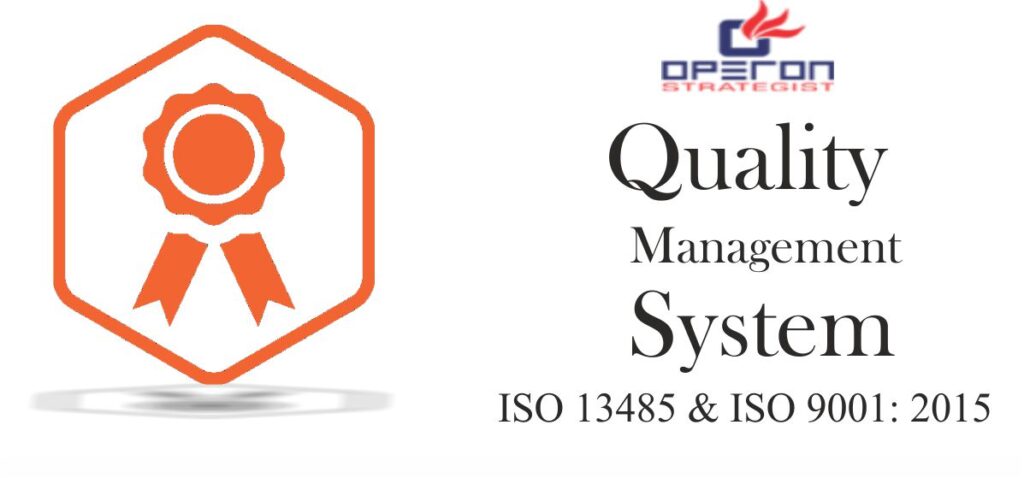ISO 13485 VS ISO 9001
QMS (Quality Management System) is an organized method or process that wraps all characteristics of design, supplier management, risk management, and manufacturing. The QMS system is the most important part of any quality and agreement process.
It is the regulatory requirement that FDA (Food and Drug Administration) and ISO auditors state as critical. It improves product quality and safety and assures ISO and FDA agreement. A QMS does the part of collecting business processes that is mainly concentrated on fulfilling consumers needs and intensifying their satisfaction.
Looking For Medical Device Regulatory Consultants?
Let’s have a word about your next project
Before, quality management systems focused on expected consequences for an industrial product line using simple methods and usual sampling. In today’s time, profits were generally the most costly inputs in industrial societies, so it started focusing on team collaboration and dynamics. QMS has frequently coincided with confirmable and clear initiatives, for both customer satisfaction and quality are attached to this factor.
At this point of time there are number of changes colliding with the medical device industries, containing a remarkable update to the industries fundamental QMS standard ISO 13485, with two new terms of regulations in Europe.
ISO 9001:2015
ISO 9001 is globally known standard to describe the requirements for quality management system in all industries. ISO 9001 provides effectual Risk assurance based QUALITY MANAGEMENT SYSTEM.QMS mainly focuses on enhancing customers satisfaction.
ISO 9001 2015 allows risk-based thinking while executing QMS, this means to recognize risk and chances in the processes to grow an efficient ISO 9001:2015 QMS with a strong customer focus.
ISO 9001 standard helps to :
- Organize processes
- Improve the efficiency of processes
- Continually improvement
ISO 9001:2015 identifies pre-conditions/requirements for a Quality Management System when a firm,
• Needs to examine the ability to continuously supply product and services that meet customers and is applicable to legislation and regulatory requirements.
• Focus to improve Consumers satisfaction with the effectual approaches of the system including the processes for improvising the system and assuring of conformity to the consumers and appropriate with the regulatory requirements.
What IS ISO 13485 For?
ISO 13485 is the worldwide acknowledged standard by the International Standards Organization for Medical Device Quality Management Systems.
Initially started in 1996, the standard states the things required for QMS that helps companies execute and exhibit the abilities to provide high quality medical devices that reach up to customers and regulatory requirements.
ISO 13485 can be used by any company involved in the transfer of medical devices at any point while the products lifecycle (encircle the design, manufacturing, providing, support phases.) Furthermore it can also be used by internal and external auditors to support inclusive audit process.
The major importance of this standard is firstly due to the fact that agreement with it is a precondition for premarket authorization in diverse parts of the world. Particularly, ISO 13485 is coordinated with EU regulations, and obedience to the standard is necessary for premarket authorization.
ISO 13485 : 2016 (Required Processes)
When it comes to QMS requirements Clauses 1-3 are introductory clauses as they describe the reason and use of the standard .In clauses 4-8 there are several additions made which contains requirements that needs to be fulfilled.
CLAUSE 4 Quality Management System
Clause 4 forms the common requirements for an efficient QMS. Essentially this part of ISO 13485 calls out the organization to recognize or describe the processes, that makes up the Quality Management System. The company also needs to apply actions based on a risked procedure to control this processes.
CLAUSE 5 Management Responsibility
Enlarged significance on regulatory requirements. This clause calls up for high management to supply proof of its allegiance to develop and maintain an efficient QMS. It means that in practice they need to grow and communicate a standard strategy with clear quality objectives.Clause 5 also issue advice on defining, documenting, communicating, responsibilities and charge in the organization
CLAUSE 6 Resource Management
Normally structuring and continuing an efficient QMS needs supplies to be committed to this task. Clause 6 also gives requirements on resource management, consisting of HR, work environment, infrastructure. This clause needs the organization to verify personnel with established proficiency. This clause also mainly states the norm to control infection with micro-organisms.
CLAUSE 7 Product Realization
This clause gives complete requirement on the operation of the organization relating to its product. The company will decide the quality objectives and bring forth processes and documents for the whole development lifecycle (design, planning, and development and storage and distribution.)Also parts such as product cleanliness, installation and service distribution are discussed in ISO 13485.
CLAUSE 8 Measurement Analysis and Improvement
This clause of ISO 13485 states how a company detects, calculates, and examines the process to exhibit QMSconformity and efficacy. Particularly there sections on detecting, calculating with (Feedback), handling complaint, internal audits, data analysis and improvement.This clause is also calls for the growth of processes and to acquire and detect consumers feedback and to handle the complaints.
There are many similarities and differences between ISO 9001 2015 & ISO 13485, and many organizations want to know what they are. These two are the biggest quality standards, (ISO 9001 2015) goes to a new high level pattern, not similar to (ISO 13485 2016), making the two standards split, going on their own way. The differences between these two standards have made the organizations concerned about how to bring them together. If situations come when you might consider of certifying both, like organizations provide related services such as contract manufacturers, suppliers, distributors may certify to ISO 13485 in addition of maintaining ISO 9001 agreement. But in general medical device manufacturers would normally choose one or the other as their structural differences would make it complicated to certify both. By understanding the differences and similarities makes the processes easier.
.
FAQ
What is ISO 13485? Is it a mandatory requirement for CDSCO manufacturing license?
ISO 13485 is the worldwide acknowledged standard by the International Standards Organization for medical device Quality Management System. The standard states the things required for QMS that helps companies execute and exhibit the abilities to provide high-quality medical devices that reach up to customers and regulatory requirements. ISO 13485 can be used by any company involved in the transfer of medical devices, providing, support phases.) Furthermore, it can also be used by external or internal auditors to support the inclusive audit process. No, it is not a mandatory requirement for CDSCO manufacturing license.
ISO: ISO 13485 is the worldwide acknowledged standard by the International Standards Organization for medical device Quality Management System. The standard states the things required for QMS that helps companies execute and exhibit the abilities to provide high-quality medical devices that reach up to customers and regulatory requirements. ISO 13485 can be used by any company involved in the transfer of medical devices, providing, support phases. Furthermore, it can also be used by external or internal auditors to support the inclusive audit process.
21 CFR Part 820: FDA 21 CFR Part 820: covers up the process used in & the facilities and controls used for the design, manufacture, packaging, labelling, storage, installation, & servicing of medical devices. Manufacturers are inspected by the US FDA as per Part 820 & only compliance with the requirements is assessed. FDA 21 CFR known as the Quality System Regulation QSR acknowledges Current Good Manufacturing Practices CGMP regulations that govern the methods used in and the services, and controls used for, the design, manufacturing, packaging, labelling, storage, installation and servicing for all finished devices willful for human use. These requirements are necessary to ensure that medical devices are safe and effective for use. Medical device manufacturers undergo FDA inspections to assure FDA 21 CFR 820 agreement.
Read more – https://bit.ly/2LTmVNP
- adminhttps://operonstrategist.com/author/admin-2/
- adminhttps://operonstrategist.com/author/admin-2/
- adminhttps://operonstrategist.com/author/admin-2/
- adminhttps://operonstrategist.com/author/admin-2/



